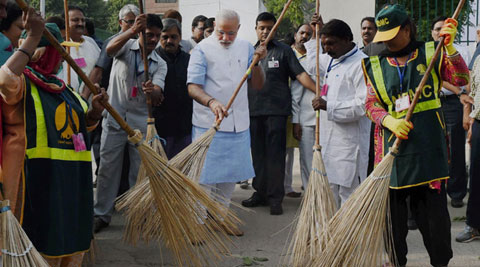 In the rhetoric that emanated from the prime minister, there was no hint of any of the radical moves Gandhi made.
In the rhetoric that emanated from the prime minister, there was no hint of any of the radical moves Gandhi made.By re-discovering Gandhi as only an icon of cleanliness, government has taken the first step towards dismantling his legacy.
As the new regime settles into office, efforts seem to have begun to shape a new thinking process and redefine our national heritage and the idea of our collective being. While the elements associated with the ruling party, but operating outside the government, have enthusiastically and somewhat aggressively started underscoring the change, the government too seems to have taken seriously the mandate that it has to change the face of India’s intellectual personality. At least initially, these efforts seem to have adopted a non-controversial and seemingly consensual tone that can easily keep convincing the pro-development lobby that Narendra Modi assiduously cultivated during the campaign. The prime minister’s televised speech on Teachers’ Day fitted with this approach. The “Clean India” drive too appears to have evoked equally enthusiastic and consensual reactions. And yet, the Gandhi Jayanti programme was a clear indication of the change that is coming.
To understand this change, we need to unravel the puzzle as to how Gandhi, with whom the Hindu nationalists always remained in an adversarial conversation even after his death, suddenly becomes an official icon of the regime based on that same Hindu nationalist ideology. This could happen only by redefining Gandhi. The government has now initiated that process. Only by taking Gandhism away from Gandhi, can “Gandhi” be converted into an icon whose words can be used as official catechism (or, as the “brand ambassador” of a new clean India!). The aggressive cleanliness drive launched by the government on Gandhi Jayanti and the marketing of the new Gandhi need to be seen in this perspective.
 Source: CR SasikumarPlanning ahead for the 150th birth anniversary of Gandhi, this drive promises to denude Gandhi of the substantive ideas he was associated with. If this effort goes on for five years, the next generation would remember Gandhi for cleanliness (only). Already, there are many, even today, who are convinced that Gandhi (only) meant cleanliness. That is why, from corporates to spiritual gurus, so many have supported the drive. Suddenly, our corporate giants have learnt from the prime minister that India needs toilets and they are coming forward dutifully to fund the drive. As Modi mentioned in his address to adoring audiences of NRIs at the Madison Square Garden, we need to build an India that “they” (Indians staying/ working in the US) dream of. In direct contrast to Gandhi, who always reminded us that public life and politics need to be anchored to the dreams and expectations of the “last man”, we are striving to make an India that would be liveable for the upper classes, lest they run away to cleaner environs!
Source: CR SasikumarPlanning ahead for the 150th birth anniversary of Gandhi, this drive promises to denude Gandhi of the substantive ideas he was associated with. If this effort goes on for five years, the next generation would remember Gandhi for cleanliness (only). Already, there are many, even today, who are convinced that Gandhi (only) meant cleanliness. That is why, from corporates to spiritual gurus, so many have supported the drive. Suddenly, our corporate giants have learnt from the prime minister that India needs toilets and they are coming forward dutifully to fund the drive. As Modi mentioned in his address to adoring audiences of NRIs at the Madison Square Garden, we need to build an India that “they” (Indians staying/ working in the US) dream of. In direct contrast to Gandhi, who always reminded us that public life and politics need to be anchored to the dreams and expectations of the “last man”, we are striving to make an India that would be liveable for the upper classes, lest they run away to cleaner environs!
But was “Clean India” Gandhi’s dream? Gandhi surely encouraged and insisted on toilet-cleaning by (particularly upper-caste) residents of the Ashram. That had symbolism much beyond cleaning the South Block by venerable officialdom. What was Gandhi’s dream? As Gandhi was wont to make somewhat complex arguments — often through his actions — this one, too, had multiple layers. At the most direct level, the “cleanliness” drive of Gandhi aimed at making sweepers out of the upper castes. This Gandhian expectation related to the supposed division of (clean and unclean) labour between the caste Hindus and the “depressed classes”. So, he was not merely aiming at a “clean India”, but an India where the act of cleaning would not be stigmatised.
The other symbolism associated with Gandhi’s shramdaan (voluntary labour) was related to the dignity of labour and the deeper claim that all labour is equally socially necessary. If the first claim sought to undercut the caste hierarchy, the second cut at the roots of the capitalist logic of demeaning productive work and keeping it underpaid. Therefore, a symbolic and media-centred activity of celebrities and power-holders on one day surely does not represent the Gandhian dream. Gandhi was not arguing for shramdaan, but the ethic of doing labour and according dignity to all work. The economy that puts a premium on non-manual work is not at all likely to bring about that dignity. And a society that tends to ensure the concentration of certain communities in low-paid and low-dignity jobs cannot ensure that dignity by an hour’s work, one day, by the privileged and the white collared. Moreover, it was not cleanliness but a social order based on equal status that Gandhi was arguing for. A drive to ensure that rural India became free of atrocities against Dalits could have been a far better candidate on the occasion.
But the larger question is not really about the swachhata abhiyan. If the drive succeeds even partially, the lives of women and of the poor would certainly be somewhat better. The crucial question is about symbolism. On October 2, 2014, the nation suddenly, willingly, suspended reason and history to demote the Father of the Nation. In the entire rhetoric that emanated from the prime minister, his other ministers, the media and the obliging intellectuals (artistes included!), there was no hint of any of the radical moves that Gandhi made. His penchant for toilet-cleaning had far too radical social implications. The Gandhi that one comes across in the “Clean India” drive is thoroughly de-radicalised.
And even then, Gandhi was not only about toilet-cleaning. On October 2, our collective consciousness seems to have willingly chosen to ignore the other equally radical ideas and practices of Gandhi. Religious harmony, equality of all religious communities and acceptance of diversity as the basis of our nationhood were integral to Gandhi’s way of approaching collective identity. A hundred years ago, Gandhi began to move Indian society in the direction of a nationhood that was non-competitive, non-combative and non-exclusionary. Nowhere in the world was there a precedent for such nationhood. Europe was then deeply immersed in linguistic or ethnicised nationhood and could think of democracy only within the context of an exclusionary nationalism. It was at that point that Gandhi (and one cannot help but mention Nehru) conceptualised and shaped a very different nationhood. It is that nationhood that forms the central pillar of India’s present.
However much the ruling party may want, on the central issue of handling India’s diverse social heritage and the complications of competitive communalism that are bound to arise in a democracy, Gandhi had a radical approach that Nehru too shared. Cleansing Gandhi of that radicalism seems to be the net intended effect of the abhiyaan to equate Gandhi with cleanliness. By addressing school kids, Modi sought to replace Chacha Nehru; and now, limiting Gandhi to cleanliness seems to be the next move in breaking the Gandhi-Nehru legacy.
Clearly, going much beyond the good governance pledge and the development promise, the new regime seems set to open a battlefront on ideas. By rediscovering a far too docile and clean Gandhi, the first step of appropriating Gandhi has been taken. We need to watch now how the new regime proceeds to dismantle the Gandhi-Nehru legacy.
The writer teaches political science at Savitribai Phule Pune University
– See more at: http://indianexpress.com/article/opinion/columns/cleansing-gandhi-of-radicalism/99/#sthash.YGDrpbNv.dpuf
Leave a Reply